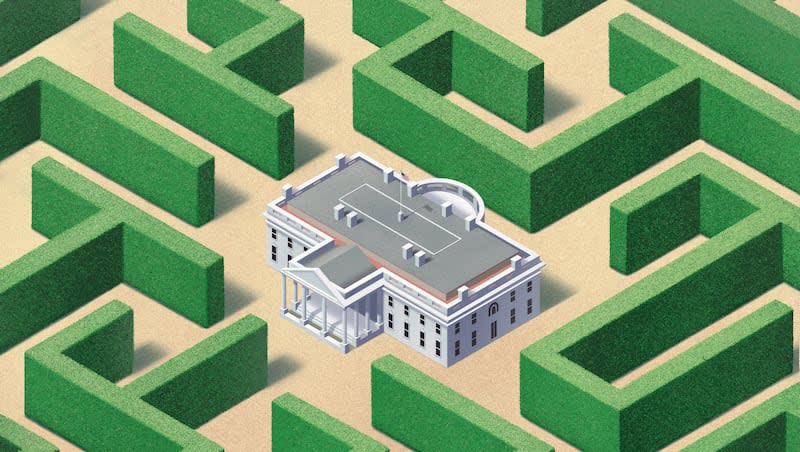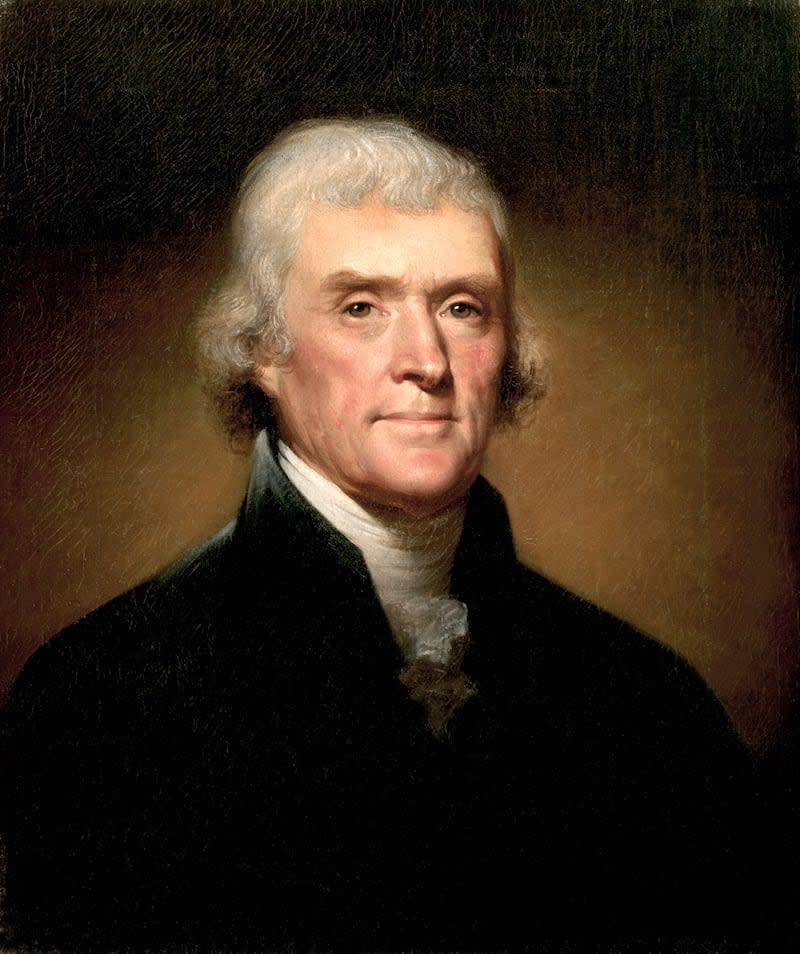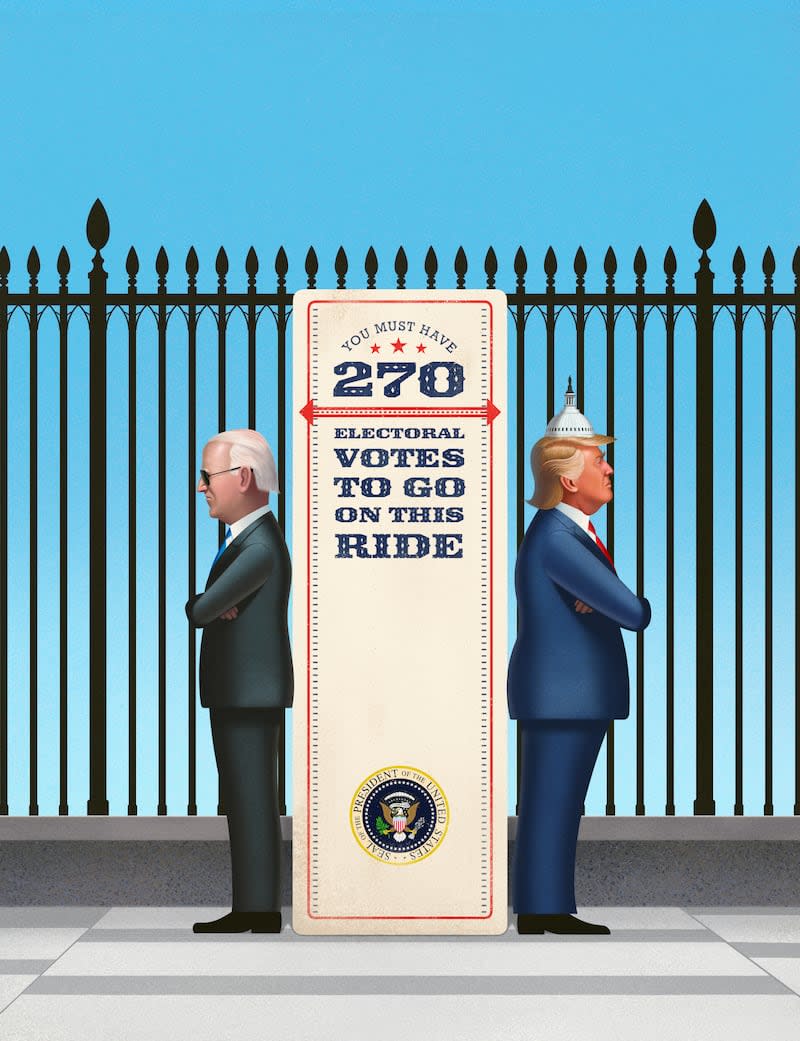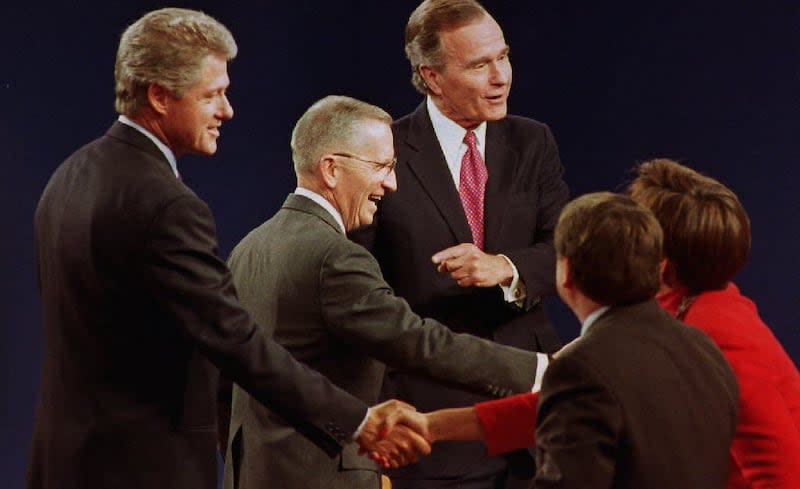Detour from democracy

- Oops!Something went wrong.Please try again later.
- Oops!Something went wrong.Please try again later.
Imagine we’ve slogged through the next six months of conventions, campaigning and TV debates. Imagine we’ve reached November 5, 2024 — Election Day. Watch as the results tumble in: Joe Biden, as he did in 2020, wins narrowly in Michigan and Pennsylvania. But Donald Trump, channeling the populism that delivered him the White House eight years earlier, wins Georgia, Arizona and Wisconsin — all of which went for Biden in 2020. The rest of the states on the red-and-blue map color in the same way they did in both previous elections. All except one.
The eyes of the nation, whether watching on CNN or Fox News, turn toward Utah, where a third-party candidate is on the verge of capturing a plurality. Biden and Trump both stand at exactly 266 electoral votes. They need 270 to win. The fate of the presidency will come down to the Beehive State’s remaining six. When the final count is in, a third-party candidate captures 41 percent of the electorate. Trump finishes just behind that candidate, at 39 percent, with Biden a distant third. The first third-party candidate to seize an electoral vote since segregationist George Wallace in 1968 would effectively prevent either major-party candidate from becoming president. What happens then?
Most Americans, for good reason, have no idea. The last time we had to ask was in 1824, when John Quincy Adams and Andrew Jackson vied for the presidency. The answer is something called a “contingent election” — a process where the House of Representatives chooses the president. That may sound great to Republicans, since their party currently controls the House, but it isn’t that simple. At a time when American democracy is fraying, with just 16 percent saying they trusted the government in 2023, a contingent election could be the poison pill embedded in the U.S. Constitution that causes the rest of the electoral system to fail.

Perhaps the third-party candidate is independent Robert F. Kennedy Jr., who has consistently polled in double figures nationwide, or unlikely spoilers Jill Stein or Cornel West. It could have been a contender tapped by centrist political organization No Labels, which had floated names like Joe Manchin, Nikki Haley and former Utah Gov. Jon Huntsman Jr. to oppose the deeply unpopular Trump and Biden, before it decided not to field a candidate after all. And perhaps the necessary electoral votes would come from Utah, where voters have shown an appetite for third-party candidates before; Evan McMullin and Ross Perot each garnered more than 20 percent in 2016 and 1992, respectively. But it’s not just Utah. A contingent election can be triggered by any third-party candidate earning a handful of electoral votes in any state.
Right now, this doesn’t seem likely. But it’s true that many Americans don’t like either major-party option. Combined with Biden’s age and Trump’s courtship of chaos, you’re left with wild cards that could still open new doors for third-party candidates in the coming months. “The odds,” says Kevin Kosar, a senior fellow studying Congress at the American Enterprise Institute, “are not insignificant.” And just one election removed from a similar loophole leading to bloodshed on January 6, 2021, this forgotten snag in the Constitution could pose a serious problem — one the author of the Declaration of Independence recognized as an existential threat to the system he helped create.
Thomas Jefferson wrote that the contingent election system is “the most dangerous blot in our constitution, and one which some unlucky chance will some day hit.”
Many features of the U.S. Constitution have endured the centuries for good reason. But the contingent election process has lasted as a matter of convenience and compromise more than inherent virtue.
Delegates to the 1787 Constitutional Convention struggled for many months to decide how to elect the president. For a long time, they thought the best idea was to have Congress choose. But that arrangement, they decided, would create conditions for corruption between the legislative and executive branches of government. They wanted something that would keep the branches more separate, but they couldn’t decide whether the president should be chosen on the basis of proportional representation, like the House of Representatives, or an equal say between the states, like the Senate. To resolve the question, a committee proposed what we know as the Electoral College, which distributes votes for president in a roughly proportional way. However, that system only found widespread support thanks to another, lesser-known compromise.
This compromise addressed what to do if the Electoral College failed to produce any candidate with an electoral majority. In that case, the election would go to the House, where every state delegation, rather than each individual member, would receive one vote for president — the contingent election system.
It sounds pretty foreign today — the Electoral College hasn’t failed to produce a winner in 200 years — but at the time, before the two-party system formed, the contingent election system, as an option, was important. Without two main candidates running against each other, there could be too much competition, the thinking went, for any candidate to secure an electoral majority. George Mason, father of the Constitution’s Bill of Rights, predicted that 19 of every 20 presidential elections would be decided by the contingent election process. “Many of the framers thought this would be the normal thing that would happen,” says Alex Keyssar, a Harvard election historian. “They thought that the Electoral College would be a sort of nominating board.” Sure enough, that’s how it went in the election of 1800.
Thomas Jefferson would eventually prevail over Aaron Burr thanks to the contingent election process. And by the next election, legislators had ratified the 12th Amendment, paving the way for the formation of the modern two-party system. “That shifted the terrain,” Keyssar says, “making it somewhat less likely — or maybe significantly less likely, over time, that it would go to a contingent election.” But the contingent election system remained in place, lurking in the constitutional shadows, ripening as an agent of chaos. Jefferson himself, despite becoming president via the method, wrote in 1823 that the contingent election system is “the most dangerous blot in our constitution, and one which some unlucky chance will some day hit.”
A single year later, his concerns rippled across the nation.
“Many of the framers thought this would be the normal thing that would happen. They thought that the Electoral College would be a sort of nominating board.” —Alex Keyssar, a Harvard historian
The election of 1824 produced the kind of outcome many of the founders foresaw: The Federalist Party had collapsed, leaving members of the Democratic-Republican Party as the only major players in national politics. With substantial disagreement and factioning within the party, and without the strict nominating procedures of today, four Democratic-Republicans competed to become president.
With 131 electoral votes required to win the Electoral College, Gen. Andrew Jackson led the way with 99, while Secretary of State John Quincy Adams trailed just behind with 84. Treasury Secretary William H. Crawford and Speaker of the House Henry Clay finished a distant third and fourth, respectively — but they captured enough electoral votes to trigger a contingent election. Few thought much of it at the beginning. “But there was a lot of electoral maneuvering going on,” Keyssar says. Especially by Clay, who held enormous sway in the House. He strong-armed many fellow legislators into supporting Adams, who prevailed in the contingent process and became president despite losing the popular vote to Jackson by a considerable margin. Adams, in turn, made Clay his secretary of state.
Jackson was furious. He told swelling crowds that Clay and Adams had made a “corrupt bargain” to keep him out of the White House. He spent the next three years building support across the nation with a populist message that used the flaws of the contingent election to his advantage: The federal government was corrupt, he argued — in the political language of today, one might say “rigged” — and his loss was proof. Clay and Adams’ quid pro quo has never been proven definitively, but Jackson’s commonsense message resonated anyway. He’d won the popular vote; he’d won the most electoral votes; and he’d been denied the presidency. It didn’t make sense, he proclaimed, even if the proper procedure had been followed. Americans seemed to agree. In 1828, he crushed Adams in a rematch.

“Thereafter,” Keyssar says, “you got a more-or-less durable two-party system.” Which means the contingent election hasn’t been needed again, though there have been some close calls. In 1948, “Dixiecrat” Strom Thurmond secured 39 electoral votes across five states, but Democrat Harry Truman’s margin of victory over Republican Thomas Dewey was large enough that it didn’t matter. Twenty years later, Wallace garnered 46 electoral votes, but Richard Nixon crushed Democratic challenger Hubert Humphrey; once more, it didn’t matter.
Then, in 1992, early polls showed independent challenger Ross Perot courting somewhere between 25 and 40 percent of the vote in a three-way matchup with Democrat Bill Clinton and incumbent George H.W. Bush. Those numbers revived high-level, bipartisan conversations about the contingent election process. The Republican House minority leader said it would be an “utter disaster,” while Kansas Democrat Dan Glickman called it a “recipe for, at minimum, chaos, and at a maximum, disaster.” The House set up a committee to study what members would actually have to do if a contingent election occurred, while the Senate met to discuss electoral reform. Once again, Democrats and Republicans agreed that the contingent process made no sense; they just couldn’t agree what to do about it.
Democrats wanted to shift from the Electoral College to a popular vote, while Republicans wanted to keep the Electoral College but replace the contingent process with a runoff election. The latter effort was led by a relatively young senator from Kentucky, Mitch McConnell. “It is nonsense,” he admitted then, “to have the House of Representatives choose the president.”
By then, Perot had dropped out. The official reason he gave was his desire to avoid a contingent election. He called the possibility “disruptive.” Whether that was the real reason or not, he recognized the risk of opening up this constitutional loophole. All three candidates did. But nothing was ever done. “The end of Ross Perot’s third-party candidacy did absolutely nothing to solve the problems inherent in our electoral process,” Arkansas Democratic Sen. David Pryor told the hearing 32 years ago. “It just pushed off the final day of reckoning.”
In 1992, Democrats and Republicans agreed that the contingent process made no sense; they just couldn’t agree what to do about it.
Most Americans remember the violence of January 6, 2021, but fewer remember what caused it. The turmoil of that day began with something called the Electoral Count Act of 1887. The law was supposed to clarify how some parts of the Electoral College should work, but it also left some things ambiguous. Namely, the role of the vice president in presiding over the counting of the votes, and whether the office has the authority to reject certain electors if they’re suspected of fraud or illegitimacy.
That’s the argument Trump made, asserting that he could be triumphant if only Vice President Mike Pence had the courage. Pence didn’t see it that way. The vice president’s role has always been a functionally ceremonial one, and that’s how he approached it. For Kosar, the American Enterprise Institute scholar, the fact that the statute left room for such varying interpretations was always cause for concern. “You saw these very clever lawyer folks and partisan politicos reading this statute in such a way that it would produce the result that they wanted,” he says. “That was distressing. … And with the Electoral Count Act, at least we had a statute to work with.”
Indeed, the procedures of a contingent election have not been clarified via statute over the centuries; we’d be relying on the language of the Constitution alone. And to throw in another wrinkle, the legislators making the decisions would be the incoming Congress, not the current Congress. With that in mind, let’s consider another real possibility.
Imagine that, in addition to some third-party candidate securing enough electoral votes to cause a contingent election, Democrats manage to win back a House majority — a very possible outcome. Even if that happened, Democrats wouldn’t necessarily be able to choose the president. Remember, the vote is by state delegations, not sheer numbers; Democrats could control the House overall, but Republicans could still hold more state delegations. Would that make a second term of Trump imminent?
No, it turns out. The Constitution says nothing about how a contingent election has to proceed, empowering the House majority to make whatever rules it wants. In this scenario, House Democrats could create rules that would effectively block Republican delegations from voting for Trump, or for anyone. Barring some party flip-flopping, this scenario would most likely result in a stalemate.

The Constitution says that in such a situation, the presidential line of succession should be followed, meaning that the vice president would become president. But picking the vice president would fall to the Senate, where a filibuster-proof 60-vote majority would be required. Neither party is expected to have that, which could mean another stalemate. Following the presidential line of succession, the speaker of the House would become president. But the speaker’s term ends when Congress does, so there would be no speaker of the House when these decisions are being made. In that case, the president pro tempore of the Senate would ascend to the presidency. “It started really upsetting me the more I thought about it,” Kosar says. “What if the Senate pro tem decides that she wants to be the president, and therefore tries to gum up the works? … It gets to be a real mess.”
That could be bad, given that few Americans can even name the Senate’s president pro tempore (Democrat Patty Murray of Washington). But consider this: The Senate could also invoke the “nuclear option,” which would drop the vote threshold for vice president to 50. If the Senate were equally divided along party lines as it is now — another real possibility — Vice President Kamala Harris could cast a deciding vote making herself president.
Contemplate, for a moment, how relatively benign the election fraud conspiracies of 2020 seem compared to a Democratic vice president voting to elect herself president.
That’s just one long-shot scenario, but it illustrates a much bigger problem. The contingent election process would introduce unparalleled levels of uncertainty, with both Republicans and Democrats highly motivated to use every obscure parliamentary trick at their disposal to keep the opposing party out of the White House. “There’s all these really perverse incentives,” says Beau Tremitiere, a lawyer with the nonprofit Protect Democracy who has studied contingent elections extensively. “It’s just a really dangerously open field with very little guidance, being handed to a Congress that has barely been able to keep the lights on, let alone do something this momentous.” And that’s at a time when the legitimacy of elections is already imperiled thanks to Trump’s lies about the 2020 results. “We’re already struggling to ensure the legitimacy of the upcoming election,” says Lee Drutman, a political scholar with the New America think tank who studies democratic representation. “To throw it into a procedure that is unfamiliar and confusing to many voters, probably 99.8 percent of voters, is just incredibly dangerous.”
Moreover, whatever Congress does, a contingent election assures a crisis of legitimacy. A president chosen by partisan horse trading and closed-doors bargaining is not going to have much of a mandate to rule — especially if Congress ends up choosing whichever candidate receives less of the popular or electoral vote. “Even when (the contingent election process) has been used, it has generated a tremendous sense of illegitimacy,” Drutman says. “And when elections are not seen as legitimate, it creates tremendous political problems.”
If the Senate were equally divided along partisan lines, Kamala Harris could cast a deciding vote making herself president.
As unlikely as a contingent election might seem in the context of America’s rigid two-party history, Kennedy’s campaign is well aware of it. His team views the contingent election process as a viable path to the presidency, and so did No Labels before it backed out.
In December, No Labels chief strategist Ryan Clancy told a group of reporters that if his group’s nominee managed to secure enough electoral votes to trigger a contingent election, it could have used those votes as a bargaining chip to form some kind of “coalition government,” becoming a power broker to swing the election one way or the other. That wasn’t the plan, he said, but they’d thought about it. In an interview with NBC News, a No Labels co-founder added that the group had already “mapped out” which states might side with them in a contingent election. “The point is,” he added, “the Constitution allows for that kind of potential.”
Is that healthy for a democracy that’s already imperiled? No Labels thought so: More choices and more voices represented in the electoral process enhances democracy. That’s one way to think about it. Another came from a bipartisan group of former lawmakers, who in early February sent a letter to No Labels to address its apparent courtship of a contingent election. “Even if No Labels could mount the most successful third-party presidential campaign in U.S. history and shatter all outside expectations, a split Electoral College is, by far, the most likely outcome. Any suggestion to the contrary is fantasy,” the group, composed of five Republicans and six Democrats, including former Colorado Congressmen David Skaggs and Tim Wirth, wrote. “A contingent election,” they added, “would be calamitous.”
Kennedy has telegraphed the same intentions. In December, the founder of his political action committee, Tony Lyons, said in a statement to Politico that he was confident Kennedy could win a contingent election. “Kennedy has two clear pathways to the White House,” he added. A statement to Deseret Magazine from Kennedy’s campaign manager, Amaryllis Kennedy, emphasized the same philosophy: He wants to win outright — but a contingent election would be welcome, too. “While we have reason to believe a contingent election would go RFK’s way,” she wrote, “we intend to win the White House with 270-plus electoral votes and the unified support of Americans across the political spectrum.”

Campaign bluster aside, such an outcome is very unlikely. Tremitiere offers another historical example: Teddy Roosevelt’s 1912 run for president on the “Bull Moose” party ticket. At the time, Roosevelt was a very popular ex-president. He enjoyed far more recognition and credibility than Kennedy or anyone No Labels could have hoped to nominate. But he lost to Democrat Woodrow Wilson by 347 electoral votes. “The historical track record here is really stacked against anyone trying to run as a third-party option,” he says. “And it’s hard to see how someone today would fare differently.” At their best and most influential, then, the most Kennedy and future groups like No Labels could reasonably hope to accomplish is trigger a contingent election. For the health of democracy, Tremitiere says, that’s far worse than not running at all.
In the abstract, most Republicans and Democrats can probably agree that a contingent election is a pretty bad way to choose the president. Whether the solution is the McConnell-proposed runoff election, the popular vote alternative floated by his Democratic contemporaries of 30 years ago, or something else, the current system isn’t something anyone today would build from scratch. So why hasn’t anything been done to fix it?
One explanation: “Legislators have way too much to do, and the other things they feel like they need to do are far more pressing,” Kosar says. And even if Congress did, somehow, recognize the disastrous potential of a contingent election and work to address it before it happens, it’s probably too late for such action in 2024. Paranoia, Kosar says, would pervade negotiations, with both sides worried that their political opponents would be working to game the reform to their benefit. “So yeah,” he adds, “it’s a problem.”
There are some reasons to be hopeful, says Audrey Perry, an adjunct professor of election law at Brigham Young University. “We’ve survived this long,” she says. “I would hope that we could survive this as well. … I would hope that this could proceed, if not in a clean manner, at least in a nonviolent manner.” Nobody really knows how a contingent election would unfold, and maybe a system that has endured for several centuries could endure this “blot,” too. But we also exist at a time when the digital world has placed what New Yorker writer Jay Caspian Kang calls a “filter of unreality” between all of us, leading to widespread, long-simmering polarization and a cross-partisan feeling among nearly 7 in 10 Americans that the country is on the wrong track. Add a presidential candidate who has made election denialism and provocation a cornerstone of his appeal, and we could be at a culmination point — one where all it takes is one big shock to the system for the whole thing to collapse.
Will “the most dangerous blot in our Constitution” prove to be as fatal as Jefferson feared? Better yet, maybe time can become the ally of American democracy. Maybe the best we can hope for, when it comes to contingent elections, is that the 200-year streak of avoiding them remains unbroken; that the day of reckoning doesn’t come any time soon.
This story appears in the May 2024 issue of Deseret Magazine. Learn more about how to subscribe.

